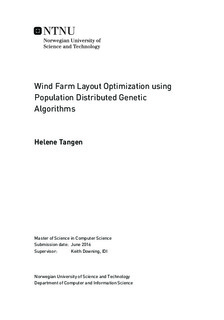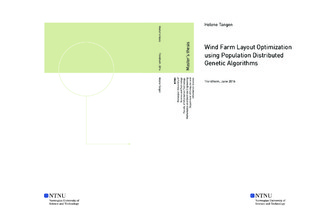| dc.description.abstract | Wind turbine technology is a promising source of renewable energy. However, the potential of wind turbine technology can not be utilized unless the wind farm layout is efficient. The challenge with wind farm layout optimization is that finding the optimal layout in the huge search space of different layouts is hard, if not impossible, to do analytically. Genetic algorithm techniques have been applied in many fields to solve non-linear optimization problems, and has shown promising results when used for wind farm layout optimization. Even so, not much effort has been put into investigating whether different genetic algorithm models can improve the results.
In this project, it is investigated if population distributed genetic algorithms are able to solve the wind farm layout optimization problem better than traditional non-population distributed genetic algorithms. This project is a contribution to a wind farm layout optimization contest launched by the Genetic and Evolutionary Computation Conference (GECCO) 2016.
An advanced genetic algorithm, containing four different genetic algorithm models, was implemented for this project. One of the genetic algorithm models was a traditional genetic algorithm, and three were population distributed genetic algorithms. The program was connected to a wind farm simulator provided by GECCO 2016 so that the performance of the different genetic algorithm models could be investigated on realistic wind scenarios.
The results showed that the traditional non-population distributed genetic algorithm consistently obtained better results than the three population distributed genetic algorithms. While two of the population distributed algorithms showed promising results, the third seemed unfit for solving the wind farm layout optimization problem. It is concluded that when providing the different genetic algorithm models the same amount of computational resources, the population distributed genetic algorithms come up short. | |

